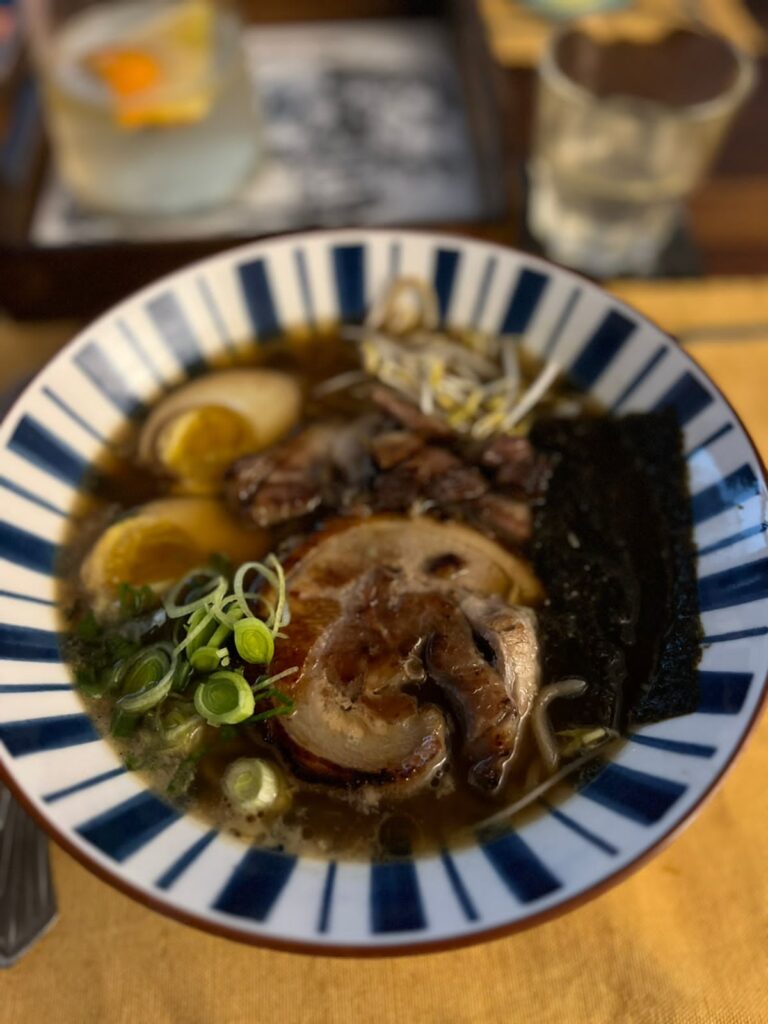
When you think of ramen, that picture you have with the little piece of rolled pork, and the softboiled egg in one corner, that’s Tokyo-style.
Sadly, there is no one “authentic” style of ramen. There is only a multitude of regional variations. But if you had to pick one, Tokyo style is probably the most traditional, in terms of what people think about when they talk about ramen.
I based this recipe on used Ramen Lords’ Homemade Tokyo-style Shoyu Ramen and the Tokyo ramen recipe in Ramen Obsession by Naomi Imatome-Yun.
What seems to make the Tokyo style distinct, is not the rolled pork belly or the soft-boiled egg, it’s the broth. Tokyo-style is one part clear chicken stock and one part dashi, a stock usually made from smoked fish (typically bonito) and sea kelp (kombu).
On that note, let’s get into it…
Ingredients for one bowl
Cooking ramen is mostly about preparation. I’m going to assume you have the elements for this bowl prepared. If you don’t, I explain how to make each element at the end of this post. If you have everything ready, then preparation time is as long as it takes to boil the water for the noodles. If you want to start from scratch, this bowl takes one full day to make (8 hours to cook the chicken stock, and the noodles need to rest in the fridge overnight). For best results, you want to let the tare sit for 1 week, but that’s entirely optional.
- 100ml dashi
- 300ml chicken stock
- 1.5 tbsp Tokyo ramen tare
- 1 tbsp chicken oil
- A handful of spring onions
- 1 slice of rolled pork belly chashu
- 1 slice of unrolled pork shoulder chashu
- 1 cured egg
- 1 strip of toasted nori
- A handful of bean sprouts
- Pinch of crispy fried scallions
- 100g ramen noodles
Preparation
Ideally, you’ll want to run 4 gas burners simultaneously to pull this off. If that’s just not an option, then two will do.
- Put the water on to boil for the noodles. This takes the longest. You want a large stock pot, the more water you have, the less it will cool down when you add the noodles.
- Put the chicken stock on to boil
- Put the dashi on to boil.
- On a low flame, heat the slices of chashu and the crispy fried scallions in a frying pan.
- Warm your bowls with one of the hot liquids on to boil.
- Then add 1.5 tbsp of tare to your bowl.
- Pour in 1 tbsp of chicken oil
- Add your fresh spring onions to the mix and swirl everything together.
- Then add 100ml of dashi to the mix.
- As soon as your chicken stock and noodle water are boiling, throw your noodles in to boil. cook for 90 seconds if you using fresh homemade noodles, or follow the instructions for packet noodles.
- While the noodles are cooking, add 300ml of chicken stock to your bowl.
- Drain you noodles vigorously and add to your bowl. Get as much water out as you can so that you don’t dilute the broth. Pull teh noodles out of your bowl with your chopstick and fold them over so that you create a bed for your toppings.
- Place your slices of chashu in the center, cut your soft-boiled egg in half and add to the bowl, your sheet of nori, a handful of bean sprouts and a small heap of crispy fried scallions on top of the chashu
- Bo no shokuyoku!
here’s a quick video of me assembling the bowl. I only had one type of chashu at this point, and I substituted the fried scallion for fresh green onions, but everything else is the same.
Making each element
Tare – makes about 700ml (enough for ~15 bowls)
Tare just means “sauce” in Japanese. It’s nothing specific to ramen. Ramen broth doesn’t have much flavor, so all of the seasoning for the bowl goes into a seasoning concoction called the Tare. For this bowl.
- 600g Soy sauce
- 60g Hon Mirin
- 10g Sea Salt
- 20g Fish Sauce
- 10g dried shrimp
- 10g dried mackerel
- Mix soy and mirin together. For best results, you want to mix the mirin and soy together and let it sit for 1 week. Something interesting happens when these flavor meld for about a week. This is optional, but if you have the time, the sum comes out greater than the parts.
- Saute your dried shrimp and mackerel with a teaspoon of neutral oil for about 10 minutes on low heat, just till the edges start to brown.
- Add everything into a saucepan and bring to a simmer. It doesn’t need to boil you just want to heat it up enough for all the salt to dissolve.
- Strain and keep in the fridge.
Chicken Stock | makes 6-8 bowls (depending on the size of the chicken)
- A whole chicken, with skin
- 8-12 chicken feet
Weight the chicken and then add 2x the weight of the chicken in water. Place the chicken in a stock pot, add the water and boil on low heat. Make a mental note of the 2:1 water mark so that you can keep topping the water up every hour or two.
Cook for 8 hours. You can cook it for up to about 12 hours. The chicken should just fall apart in the pot when you’re done. Make sure you maintain the 2:1 water level. don’t let the water boil. You want the heat to be just under boiling point. Boiling will agitate the water and make the stock cloudy. You want this stock crystal clear.
When you’re done, strain the stock, let it cool and keep it in the fridge overnight. You want to cool the stock fairly quickly since it’s the ideal breeding ground for bacteria. If you have a ceiling fan then pour the stock into as many bowls as you can to increase the cooling area. Or you can create a little ice bath and pour to stock into a pot sitting in the ice bath.
The next morning you want to scrape all the fat off the top, which you will use in the chicken oil for the bowl. Keep as much stock as you plan to use for the week in the fridge and store the rest in the freezer for up to 3 months.
Dashi – makes 1.2 liters
- 120g Kombu
- 3 tbsp Hondashi
- 20g Shitake
Hondashi is a substitute for bonito flakes. This is basically the vegetable stock cube of Bonito flakes. Any self-respecting ramen chef would throw up in their mouth if they saw me using hondashi. The real stuff, bonito flakes or katsuobushi, is poached, smoked, and fermented skipjack tuna. This is the most crucial ingredient in this bowl. But, I live in India, and bonito flakes are not an option. I’d like to set up my own smoking operation, but till then, Hondashi is the best I could do. If it helps, I’m not proud of this.
To mask the manufactured flavor of hondashi, I found that 1 tbsp for every 400g liquid is enough to hide the chemical taste but keep the smokey flavor.
- Soak 120g of kombu and 20g of shitake in 1.2 liters of water overnight
- Remove the kombu and shitake and add 3 tbsp of Hondashi.
- Bring to a simmer but don’t let it boil. Boiling kombu breaks down the umami flavor, so no boiling.
- Let it cool, and then store it in the fridge.
Chashu
For Chashu I will defer to Adam Liaw here on how to make both types.
Cured egg
There is no perfect softness for your ramen egg, there are only preferences.
This video lays out what your options are how long you have to cook and egg for each.
Reagrless of what option you go for, I would recommend picking the option slightly softer than what you like and then letting your egg sit in teh braising liquid from the Chashu above for 2 days. The salt in the braising liquid will draw out the liquid in the egg and cook it slightly.
Noodles
If you want to go the whole hog and make your own noodles, I fully support your decision. I didn’t start making my own noodle much too late into the game. I wish I’d started sooner because it makes a massive difference to the overall experience of your bowl.
This is the recipe I started with, and I’m recommending it because it’s so easy to follow along to.
For a tokyo-style bowl you want medium-cut noodles, and ideally, they should be crumpled so that they’re wavy.
And that’s it.
Lessons learned…
What worked
This is hands-down the best bowl of ramen I’ve worked on to date. The texture, the flavor profile, the portion size. I give myself a clean A on this bowl.
What could be improved
- If I could get my hands on some real katsuobushi and ditch the hondashi, I think that would bump this bowl up a notch.
- Menma (fermented baby bamboo shoots) also seems to be a popular topping for this bowl. I could only get the bottled version which wasn’t great, so I ditched it, but some fresh menma would be an excellent addition.
- Kamaboko is a puréed white fish, formed into a cylindrical loaf and steamed until it becomes firm. I didn’t have the time to figure this topping out but would love to work on a version of it the next time I make this bowl.
